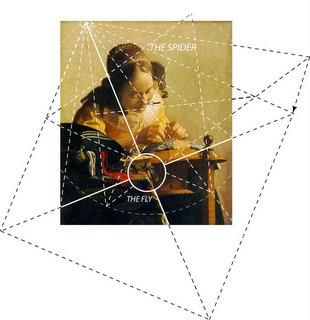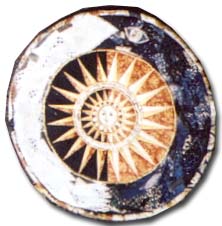Friday, March 02, 2007
Thursday, March 01, 2007
Moths Elude Spiders by Mimicking Them, Study Says
Moths Elude Spiders by Mimicking Them, Study Says: "The arrival of a jumping spider sends most moths into a flutter trying to escape the predator's lethal pounce.
Not so for metalmark moths in the genus Brenthia. These moths stand their ground with hind wings flared and forewings held above the body at a slight angle."
Not so for metalmark moths in the genus Brenthia. These moths stand their ground with hind wings flared and forewings held above the body at a slight angle."
Monday, October 16, 2006
Friday, September 29, 2006
Silky-footed tarantulas don't come unstuck
"To figure out how tarantulas make their way safely up vertical surfaces, Adam Summers of the University of California, Irvine, and colleagues analysed the footprints of Costa Rican zebra tarantulas (Aphonopelma seemanni) as they climbed a glass wall. This revealed that the spiders left fragments of sticky silk a few micrometres in diameter and up to 2.5 centimetres long."
Thursday, June 15, 2006
Early web-spinner found in amber
"True orb weaving spiders found trapped in amber from 121-115 million years ago are the oldest of their type yet found."
Monday, June 05, 2006
Through the Spider's Web
An international Photography exhibition devoted to spiders. Some cool ones in there.
Tuesday, May 30, 2006
Vietnamese spiders
Cool photographs and descriptions, including a semi transparent Argyrodes: "This is perhaps the most amazing spider I've ever seen. It was the strangely shaped abdomen that first made me take notice, and only when I got home did I notice the transparent window in the abdomen. It took a little bit longer before I noticed what was visible through the window - eggs! This spider had several dozen babies with it on the web it had built on a wide piece of grass, and it looks like it has several dozen more eggs waiting to be hatched. " Thanks, PK.
Wednesday, May 17, 2006
Kauai Wolf Spiderlings
"No one had ever photographed a baby Kauai wolf spider being carried on its mother's interlocking back hairs until two Hawaii scientists caught the shot."
Wednesday, May 10, 2006
Peculiar spider bearing a human face on the back
The photo taken on April 18, 2006 at Liaocheng, a city in east China's Shandong Province, shows a pea-green spider with a human face-like mark on its body.
Tuesday, April 11, 2006
Natural selection of the redback spider
"A new study by researchers at the University of Toronto, Canada, has observed the developmental adaptations in male Australian redback spiders and found that they develop faster with more females around them. "
Why A Spider Hanging From A Thread Does Not Rotate
"The extraordinary properties of spider's thread are like a blessing for researchers working on polymers. However, the amazing twisting properties it displays are still not very well understood. How can one explain the fact that a spider suspended by a thread remains completely motionless, instead of rotating like a climber does at the end of a rope?"
Sunday, April 09, 2006
The Leaf curler
The leaf curling spider (Phonognatha graeffei, Family Tetragnathidae) is ubiquitous in the Sydney area. They're everywhere, and you can easily pick them out in the undergrowth by their pretty distinctive webs. They build a typical orb web but with a twist- literally. On the upper part of the web, you can usually see a dried leaf that's been curled in to a retreat, and the spider usually pokes its legs outside the leaf.
While it is not uncommon for orb spiders of the family Araneidae to build retreats, the leaf curler is one of the few (as far as I know) that actually incorporates the leaf into the web. I've read that they actually pull up leaves from the ground in order to incorporate them into the web. I don't know whether there is any preference for particular leaves, I've never bothered to find out what plants are preferred, if any. The male is known to cohabit the retreat with the female.
I had some vague hypotheses about whether the choice of the leaf is important, or whether the leaf offers any advantage other than the obvious one of protection. For example, it has been shown in some spiders that the orb web is distorted on the vertical plane so that it is harder for approaching insects to see the web and thereby facilitating their capture. Maybe the leaf functions in the same way, breaking up the pattern of the web.
When I went looking for these spiders in the small woodland area behind the lab, I came across a few Leaf Curlers that had build their webs such that the leaf was still attached to the plant. This was more akin to the retreats seen in other orb spiders, and which somehow lends weight to the protection hypothesis. But these individuals could be of a different species or very few in number in the population. Still if it's the same species, it's an interesting variation in web building pattern.
Like other orb weavers, it looks like Leaf Curlers are also vulnerable to kleptoparasitic pressure. If you look at the second photograph, you might notice a small dot in the left of the leaf. I took a closer look at it and it turned out to be a spider of the Genus Argyrodes (Family: Theridiidae).
I will write a longer post about them someday, but for now, it suffices to say that these small spiders live on other spiders webs and eat/steal scraps from the bigger spider.
Back to the Leaf Curlers, here's a nice thought experiment that I, well, thought of a while ago. It would be cool to place an individual in a glass cage and give it only one artificial material, say like a ribbon or something and see if it uses the material anyway. Bit of an art project really, bio-art.
Note: All photographs taken by Ajay Narendra.
Monday, February 13, 2006
Assassin Spiders: "They may be small, but Assassin spiders are among the most dangerous spiders on the planet – if you’re another spider, that is. These tiny arachnids in the Archaeidae family are only about 2 mm (less than 1/8 inch) long, but their bizarre fangs and spider-hunting practices have earned them a reputation as the world’s most grotesque spiders."
Sunday, January 29, 2006
Nemesiario Another spider blog!!! In Spanish. (hola, compadre!)
Tuesday, January 17, 2006
Tuesday, December 20, 2005
Carl Wilhelm Hahn: "Dr. Carl Wilhelm Hahn was a German zoologist and author of the first German monograph on spiders"
Monday, December 19, 2005
Spiderling :: Mexican Red Knee: "The aim of this BLOG is to give an insight into how I decided to set up and look after a Spiderling. The species I went for was the Mexican
Red Knee (also know as Brachypelma Smithi)"
Red Knee (also know as Brachypelma Smithi)"
Wednesday, November 30, 2005
Tuesday, November 29, 2005
Saturday, November 26, 2005
A natural history of spiders and other curious insects by Eleazar Albin
Tilly, London, 1736!!! Thanks PK
Tilly, London, 1736!!! Thanks PK
Harun Yahya - The Miracle In The Spider:
It's quite funny to read this book. the guy makes a good enough description of the spider's behaviour etc, but when it comes to an explanation, he always has the same explanation for each of the spider's habits: because god made it so. It's too complicated...so it must have been created.
"It is clear from this that when one carefully examines the characteristics of the Bolas spider, one gets a better understanding of just how comic the claim of the theory of evolution, completely based on coincidences, is. That coincidences will be unable to bring the spider into possession of the features we have discussed above, that is, intelligence, planning and tactics, and, furthermore, that even with time the spider will be unable to bring these about itself, is clear. There is no need to think long and hard or to do research in order to grasp this. Using a bit of common sense will be enough to see this obvious truth.
It follows that the evolutionists' scenarios are blatantly false. All that is left is the truth: The situation we are discussing needs a very special act of creation. It is God Who created all living creatures, plants, animals, and insects. God has infinite power, knowledge, intelligence, and wisdom:
'Lord of the heavens and the earth and everything between them, the Almighty, the Endlessly Forgiving,' (Surah Sad: 66)"
It's quite funny to read this book. the guy makes a good enough description of the spider's behaviour etc, but when it comes to an explanation, he always has the same explanation for each of the spider's habits: because god made it so. It's too complicated...so it must have been created.
Secret Lives of Spiders poems about spiders
British Spiders : "The Families of Spiders Represented in the British Isles"
Saturday, November 19, 2005
Spiders (a harp composition): "Spiders was first performed by Sioned Williams in London at the Wigmore Hall in 1985. No doubt when hearing this piece all sorts of images will be conjured up of the enchanting world of the spider. The very sight of the harp strings always reminds me of a spider’s web and perhaps the harpist hands and fingers could be likened to that of the spider weaving a complicated web"


